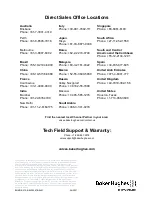
110 | Baker Hughes.
© 2021 Baker Hughes Company. All rights reserved.
• Positioner Cycling – If no stick slip is present and the position cycles are much
greater than setpoint cycles, then most likely the positioner is causing the cycling
(poor positioner tuning).
Error and Offset:
The error KPIs are useful to diagnose differences between setpoint and position, serving
as a leading indicator to other valve performance issues. Error is the absolute value of the
difference between Setpoint and Position. Offset is the difference between position vs.
setpoint, expressed in %, and showing the /-(above or below setpoint). Large
setpoint changes are ignored until position is within 1% of setpoint or after 5 seconds,
whichever happens first. Both error and offset are continuously calculated and are
checked against the programmed limits every hour.
Tight Shutoff Cycling:
Tight shutoff cycling is defined as the number of times the positioner enters and then exits
tight shutoff mode. The SVI3 detects when it enters tight shutoff mode (setpoint less than
tight shutoff threshold). When the setpoint rises above the threshold (plus deadband), the
positioner will no longer active tight shutoff mode and a cycle will be counted. A counter is
incremented with every cycle calculated, and a rate is determined based on the number
of cycles in an hour. If no cycle is determined in 20 minutes, the rate will reset to zero.
Tight shutoff cycling can occur if the DCS is controlling the valve close to the tight shutoff
threshold value. Or it can happen if a calibration error exists where the positioner is
reporting a much different position value than the actual valve position.
Obstruction:
The obstruction KPI helps to determine if the valve is unable to move in a certain direction
in response to a given setpoint. The SVI3 will look for an obstruction by monitoring
setpoint and position while the valve is stable (i.e. not moving). If position error exceeds
2% for a specified period of time, then the device will interpret this as an obstruction, and
obstruction indicator will be set (either low or high).
Obstruction can help to identify valve problems such as a handwheel blocking valve
stroke, a broken stem, or disconnected position feedback components.
Calibration Error:
Calibration Error is a measure of error at the stops of the valve. At the stops, we expect
the position to be either 0% or 100%. If any error exists, that difference is reported as a
calibration error of the device.
Calibration error can be useful to determine issues with the internal valve components,
such as seat erosion, which could cause the lower stop to now register a different position
from the original stop calibration when the valve was new.
































